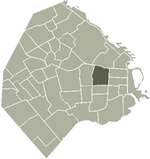Balvanera
| Balvanera | ||
|---|---|---|
| Barrio | ||

Clockwise from top: the Argentine National Congress Palace, Confitería El Molino, the Abasto neighbourhood and The Water Company Palace.
|
||
|
||
 Location of Balvanera within Buenos Aires |
||
| Country |
|
|
| Autonomous City | Buenos Aires | |
| Comuna | C3 | |
| Important sites |
Plaza Miserere National Congress UBA's Economics Faculty |
|
| Area | ||
| • Total | 4.4 km2 (1.7 sq mi) | |
| Population (2001) | ||
| • Total | 152,198 | |
| • Density | 35,000/km2 (90,000/sq mi) | |
| Time zone | ART (UTC-3) | |
| The neighbourhood is often referred to as Once | ||
Balvanera is a neighborhood ("barrio") of Buenos Aires, Argentina.
The official name, Balvanera, is the name of the parroquia (parish) centered around the church of Nuestra Señora de Balvanera, erected in 1831.
The zone around Corrientes avenue is known as Once after Plaza Once de Setiembre, the alternative name of Plaza Miserere (the square in which president Bernardino Rivadavia's mausoleum is located).
The south-eastern part of Balvanera is often called Congreso, as it contains the Congress building and the neighboring Plaza del Congreso (Congressional Plaza).
The north-western part of Balvanera is referred to as Abasto after the landmark Abasto market (now a shopping mall; see below).
Until the 1860s, Balvanera was considered an outskirt of Buenos Aires proper. In 1836, a census set its population at 3,635. Most inhabitants lived in quintas (small estates), and the zone was known as las quintas. The Camino Real (now Rivadavia) was the main road from the city to the west.
In the late 19th century, Balvanera had a strong political tradition, identifying first with Adolfo Alsina and then with UCR leaders Leandro Alem and Hipólito Yrigoyen.
By 1900, Balvanera was associated mostly with violently contested elections—and with the brothels in the Junín y Lavalle area where, according to Borges, the tango dance acquired its notorious erotic overtones. Natural growth and railroad development eventually assimilated the neighbourhood into the city.
During the 1910s and 1920s, the area around Corrientes avenue became the center of Buenos Aires's Jewish community and the hub of the garment trade, which in turn attracted segments of the Arab and Armenian communities.
...
Wikipedia

